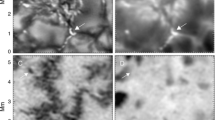Abstract
Following a description of the Evershed effect as observed by John Evershed in 1909 at the Kodaikanal Solar Observatory, we discuss the evolution of our scientific understanding that accompanied the development of the subject of magnetohydrodynamics (MHD). How the modern telescopic observations as well as the computational capabilities are serving to uncover the complex magnetohydrodynamic processes behind this highly dynamical phenomenon is discussed at length.
Similar content being viewed by others
Suggested Reading
J Evershed, Radial Movement in Sunspots, Mon. Not. R Astron. Soc., Vol.1\( \bar 9 \), p.454, 1909.
T G Cowling, Mon. Not. R Astron. Soc., Vol.96, p.15, 1935.
H Alfven, Nature, Vol.150, p.405, 1942.
J Larmor, Brit. Ass. Advan. Sci. Rep., pp.159–160, 1919.
L Biermann, Vierteljahressehr. Astron. Ges., Vol.76, p.194, 1941.
T G Cowling, Solar Electrodynamics, edited by Gerard P Kuiper, The University of Chicago Press, p.532, 1953.
P A Sweet, Vistas in Astronomy, Vol.1, p.675, 1955.
R E Danielson, The structure of sunspot penumbras II, Theoretical, Astrophys. J., Vol.134, p.289, 1961.
D J Galloway, Fine structure and Evershed motions in the sunspot penumbra, 1975.
F Busse, Sol. Phys., Vol.44, p.409, The Role of Fine-Scale Magnetic Fields on the Structure of the Solar Atmosphere, Proceedings of the Inaugural workshop and round table discussion for the D-E-S Telescope installations on the Canary Islands, La Laguna, Tenerife, Spain, 6–12 October 1986, Edited by E-H Schröter, M Vazquez, and A A Wyller, Cambridge, Cambridge University Press, p.187, 1987.
K Jahn and H U Schmidt, Thick penumbra in a magnetostatic sunspot model, Astron. Astrophys., Vol.290, p.295, 1994.
R Schlichenmaier, K Jahn and H U Schmidt, Magnetic flux tubes evolving in sunspots. A model for the penumbral fine structure and the Evershed flow, Astronomy and Astrophysics, Vol.337, p.897, 1998.
F Meyer, and H U Schmidt, Mitteilungen der Astronomischen Gesellschaft, Vol.25, p.194, 1968.
B Montesinos and J H Thomas, The Evershed effect in sunspots as a siphon flow along amagnetic flux tube, Nature, Vol.390, p.485, 1997.
Scharmer et al, ApJ Letters, Vol.677, L149, 2008.
Rempel et al, Astrophysics Journal, Vol.691, p.640, 2009.
Author information
Authors and Affiliations
Corresponding author
Additional information
S P Rajaguru is Reader at the Indian Institute of Astrophysics, Bangalore. His research interests involve applying helioseismology and astrophysical magnetohydrodynamics to study solar magnetic fields and ‘solar activity’ and is also interested in similar studies of stellar magnetic fields.
Rights and permissions
About this article
Cite this article
Rajaguru, S.P. The Evershed effect as we understand it today. Reson 14, 1040–1046 (2009). https://doi.org/10.1007/s12045-009-0099-0
Published:
Issue Date:
DOI: https://doi.org/10.1007/s12045-009-0099-0




